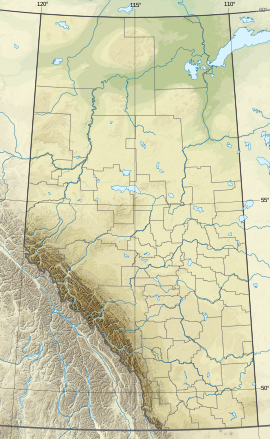Chak Peak
| Chak Peak | |
|---|---|
 Chak Peak seen from Cavell Meadows Trail | |
| Highest point | |
| Elevation | 2,775 m (9,104 ft)[1] |
| Prominence | 235 m (771 ft)[1] |
| Parent peak | Franchère Peak 2805 m[1] |
| Listing | Mountains of Alberta |
| Coordinates | 52°42′43″N 118°07′38″W / 52.71194°N 118.12722°W[2] |
| Geography | |
| Location | Jasper National Park Alberta, Canada |
| Parent range | Canadian Rockies |
| Topo map | NTS 83D/09[2] |
| Climbing | |
| First ascent | 1915 Topographical Survey[1] |
Chak Peak is a 2,775-metre (9,104-foot) mountain summit located in the Athabasca River valley of Jasper National Park, in the Canadian Rockies of Alberta, Canada.[2] Chak is a name derived from the Stoney language meaning "eagle".[3] Precipitation runoff from Chak Peak drains into Portal Creek and Astoria River which are both tributaries of the Athabasca River.
Climate
Based on the Köppen climate classification, Chak Peak is located in a subarctic climate with cold, snowy winters, and mild summers.[4] Temperatures can drop below -20 °C with wind chill factors below -30 °C.
Geology
The mountain is composed of sedimentary rock laid down during the Precambrian to Jurassic periods and pushed east and over the top of younger rock during the Laramide orogeny.[5]
See also
References
- ^ a b c d "Chak Peak". Bivouac.com. Retrieved 2019-03-30.
- ^ a b c "Chak Peak". Geographical Names Data Base. Natural Resources Canada. Retrieved 2021-01-03.
- ^ Place-names of Alberta. Ottawa: Geographic Board of Canada. 1928. p. 32.
- ^ Peel, M. C.; Finlayson, B. L. & McMahon, T. A. (2007). "Updated world map of the Köppen−Geiger climate classification". Hydrol. Earth Syst. Sci. 11: 1633–1644. ISSN 1027-5606.
- ^ Gadd, Ben (2008), Geology of the Rocky Mountains and Columbias


